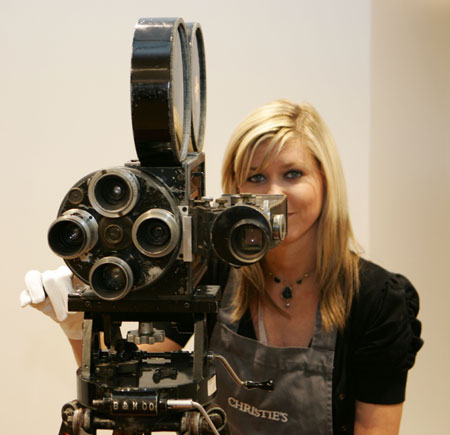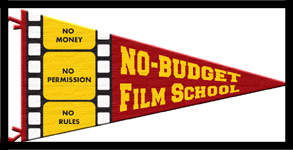|
 | | |
| Don't get carried away with your camera |
In the past couple of weeks I’ve consulted with three different producers about their no-budget
films and inevitably, the area we spent the most time discussing was camera selection. CAMERA SELECTION. Not acting.
Not script or story. Not sound. Not locations. Camera. Now, I understand this. It’s logical,
as cinema is the only art form where everything that happens has to go through this little lens before it becomes available
to an audience. And on a set so much energy is concentrated around that piece of equipment and the person who lords
over it—the DP. And of all the elements in a film, perhaps nothing changes faster than camera technology, and
with that change comes uncertainty and questions.
And while
I dutifully try to answer the question of which camera to use, my real answer is pretty much always, “Who cares?”
Because ultimately, it doesn’t really matter what camera you use. It really doesn’t, and I have the films
and my own experience to prove it. In all honesty, the camera you choose is probably the least important decision you
can make with respect to how successful your film will be. In all my years of working at Next Wave Films, and all the
thousands of films I looked at, our decision of which film to invest thousands of dollars in for finishing funds never came
down to what camera was used. With all the important decisions to make on a film, and with the paucity of resources available
to you on a no-budget film—both time and money—how your film looks with respect to this camera choice is nearly
irrelevant compared to all the other things you need to get right—the things that people who make decisions that will
impact your career really care about. The bottom line is, your film just needs to look good enough. The look needs
to serve the story you’re telling, so if you’re telling an intimate character-driven story, (and odds are, if
you’re working on a micro-budget, you’re telling an intimate something), then the look doesn’t need to rival
Pirates of the Caribbean. Every single successful Mumblecore movie made over the past six years bears this out—and there have been a bunch of successful Mumblecore movies made
over the last six years that have launched the careers of the filmmakers who made them.
 | | |
| The homemade camera used on “Bellflower”
| I have
other examples. I saw a film called Jellysmoke at the 2005 LA Film Festival. It was shot on 16mm and projected digitally and clearly wasn’t finished.
The edits were rough, the sound wasn’t designed or mixed yet, and overall it looked like shit. But the film was
compelling enough to win the $50,000 Target Filmmaker Award. At the 2000 LA Film Festival I was a producer on a documentary
called Keep The River On Your Right. We were trying to finish our video-to-film transfer in time for the festival (there really wasn’t digital
projection yet) and the only way to finish was to do a temp job on all but the first reel. Reel one looked terrific,
reels two through five looked like crap, and there was even a blip in the last reel that threw the final 10 minutes a second
or so out of sync. The result? We won the documentary grand jury prize at the festival. One of the most
successful films I saw in the NEXT section at Sundance this year, Bellflower, which was shot for $5000 on a homemade camera and picked up for distribution by Oscilloscope, also had major issues
with their picture. There was a whole scene where they cut back and forth between two shots and one of those shots had
some kind of smudge all over the lens. A Hollywood studio film might not be able to survive mistakes like these, but
smaller, scrappier independent films often can. It’s something I call Organic Evenness. As long as the production
values are at an even par with each other, then the film won’t seem low-budget. As soon as one value far exceeds
another, though, the rest of the values start to look cheap in comparison. Be aware of where your story and production
fall in line and work accordingly.
You’ve heard this
many times—the camera is a tool. (Sometimes, your DP is a tool, too). You need to pick the best tool for your
specific job. In the no-budget world where a book-rate camera rental might make up 25% of your production budget and
a particular format might add one or two extra people to your set that you may have to pay and will definitely have to feed,
this decision is certainly important, but not for the reasons you’re thinking. Pick a camera that you can own
or borrow (anytime you need it), one that’s easy enough for you to operate, (because there will be a pick-up or an insert
that you will have to shoot yourself), one that’s been used by many filmmakers ahead of you (and hopefully a few you
know personally), one that doesn’t have a workflow that will bog you down on the set or in post, and perhaps one that
is small and inconspicuous, depending on the type of shooting you plan to do.
 | | |
| New Sony ‘Super 35’ FS100 |
Based on today’s technology and what’s
readily available, I recommend an HD camera that shoots 24p to tapeless media, and that has XLR inputs for your professional
mics. If shallow depth of field is important to your look, then I recommend the kind of large sensor found on a host
of cameras, including the popular Canon DSRLs (5D, 7D, 60D, T3i) and the new full-featured video cameras by Panasonic (the AF-100) and Sony (the FS-100). There is plenty of information on the internet to help you decide among these different choices, but just remember,
they will all do a terrific job. They all produce incredible images if used properly. Some offer enhancements
that might be better suited for your particular project and some are ultimately a little easier to control and work with.
But I can assure you that if all you had to work with was a free Canon 7D that a friend lent you, you’d be able to find
a way to make a good looking film with it, (See Tiny Furniture, which was shot on the 7D with very little money and a tiny crew and was ultimately nominated for Best Cinematography
at the 2011 Spirit Awards against much bigger films).
And that’s really the thing—making do. You’re going to have to “make do” all
throughout the filmmaking process on a no-budget film. Successfully making do is what I call in my classes Embracing Your Limitations. To me, this is one of the key components to success on a micro-budget feature. The
best no-budget filmmakers don’t suffer what they don’t have, they embrace their situations and not only learn
to accept their lot, but also find advantages inherent in their particular circumstances. Embracing Your Limitations
is a complicated and difficult idea (and one that I spend a good 45 minutes covering in my class—it’s that crucial),
but I can tell you that it starts with this camera decision. If you’re sweating all the differences between the
AF-100 and the FS-100, or can’t imagine shooting with any camera other than a RED because of everything you’ve
heard about 4k and dynamic range, then you’re already starting off on the wrong foot psychologically to make your no-budget
film. You’re not embracing your limitations, you’re trying for perfection. And perfection is not what
you’re going to get on this film, nor is it critical in this area. No one is going to notice that dynamic range,
especially on the standard def DVD you have to send to every film festival you submit to or on the less-than-perfect projection
you’re going to encounter at every one of those festivals you get accepted to. What everyone will notice is how
amazing your lead actress is and how incredibly powerful her story is.
You’re almost better off doing what filmmaker Zack Godshall did for his latest film Lord Byron, which was made for $700 and recently premiered at the 2011 Sundance Film Festival. While he’d shot with a Panasonic
HVX-200 on his first Sundance feature, the excellent Low And Behold, he didn’t
have access to that camera on this film and had no money to buy or rent anything else. What he had was an old Sony Z1u,
which he owned and knew how to use (and he was his own DP on the shoot). This camera is not only HDV (breaking my tapeless
“rule”), it’s also not 24p (breaking that “rule”). Almost no one would shoot a narrative
film today on a non-24 frame camera, but when you decide you’re going to make an entire feature for less than $1000,
starting with that camera decision puts you in the proper frame of mind to make all those other difficult decisions you’re
going to have to make and accept all those other things you’re not going to get. And once you’re in that
mode, the process begins to free you up to concentrate on what you do have—your actors (non-actors, in this case), your
story, your locations (which were easily accessible for their 3-man crew and informed the story in a vital way). This
is where you want to be for most no-budget projects. Let go of all that stuff that doesn’t ultimately matter and
focus on the good stuff!
ARCHIVED EDITIONS OF THE NO BUDGET REPORT:
|

